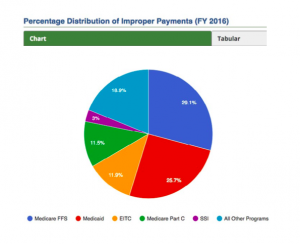This blog post is an excerpt from GovLoop’s recent guide “Analytics in Action: How Government Tackles Critical Issues With Data.” In this guide, we share firsthand accounts from government employees at all levels who are using analytics to identify critical issues and find solutions. Download the full guide here.
The Do Not Pay Business Center within the Treasury Department’s Bureau of the Fiscal Service provides analytics services to agencies across government. Its goal is to improve the integrity of federal payments and detect, prevent and stop improper payments in addition to payments affected by fraud, waste and abuse of taxpayer dollars.
GovLoop spoke with Joah Iannotta, Director of the Do Not Pay Business Center, to learn more about what she’s doing to combat improper payments in the federal government.
GovLoop: What issues is your organization trying to tackle?
Iannotta: Do Not Pay was created as a way to help agencies address the governmentwide challenge of improper payments. We do that in two key ways. The first is that we have an online portal that automates data matching between different data sources than can help agencies screen against eligibility issues.
The second thing that we do is provide analytics services. Legislation has given Do Not Pay six different data sources related to death, federal debt and lists of individuals and parties who’ve been excluded from doing business with the government. Our analytics services are about trying to help agencies at a more programmatic level tackle an improper payment challenge that’s specific to that program.
GovLoop: How are you using data and analytics to address those issues?
Iannotta: Our analytics service has developed a few different areas of focus. One is payment integrity controls. These are internal controls [and] data-centric tests that agencies can use to identify risk in a payment stream. For example, if you look at payments to vendors, there may be certain types of vulnerabilities around payment errors or payments that may have been a ected by fraud, waste or abuse. And so developing analytics to detect how those kinds of risks show up in the data [helps] an agency flag a payment before they disburse it.
Fiscal Service disburses close to 90 percent of the federal government’s payments. We’ve developed a suite of tools that we can offer to agencies where we can go in and do pattern and trend analysis and anomaly detection to try to identify risk in the data that could indicate an improper payment, whether it’s due to administrative error or something intentional.
GovLoop: Can you share a time when your organization used analytics to drive better decision-making?
Iannotta: The whole process of identifying payments that are at risk is a way of facilitating agency decision-making. We’re providing information on individual payment records that allows an agency to make a determination about whether or not that payment was truly improper.
GovLoop: Can you share tips on how you got the data you needed and decided what tools/techniques to use?
Iannotta: The legislative landscape can be challenging. Make sure that you have excellent privacy and legal staff with you to help navigate that legislative landscape. Our strategy has been to facilitate data sharing to help agencies leverage and harness the power of data. We have the staff who can help agencies walk through that legislative landscape.
At the end of the day, if you have amazing data scientists and analysts, that is an incredible resource.
GovLoop: What were the resource requirements?
Iannotta: We have about nine data scientists and data analysts on the analytics team, who turn out a lot of work. I think people get hung up on the tools and forget just how important it is to have somebody who can code the data and also translate the results into something that’s actionable and business-oriented.
The other resource that people don’t necessarily think about is [all] the data [that] is available. Finding that right balance between what kind of data you need on hand in order to really put your analysts in a position to do really interesting things and solve problems is another resource balance that you have to think about.
GovLoop: What was key to your success with analytics?
Iannotta: Something that’s been extremely important for Do Not Pay is applicability. [It’s] about trying to refine the solution for that particular program so you get true matches. You get high-risk payments and you don’t get false positives. What’s been key to being successful in that space has been a strong partnership with the agency that we’re working with and being able to use an iterative process with them to refine those results.
GovLoop: How are you creating a culture for analytics at your agency?
Iannotta: Within Fiscal Service, people crave information. It hasn’t been much of a lift here to get people to be excited and want to leverage analytics. What has been more challenging has been our work with agencies. Getting folks to see how analytics can benefit them has been really important. For us, the solution was being able to talk to agencies about how the information can help them to make good resource decisions and how it can help them to identify improper payments in a way that is efficient and effective. It’s really making that business case for the value of analytics.
GovLoop: What do you hope to do with data and analytics in the near term and long term that you cannot do today?
Iannotta: We would like to be able to help agencies address a broader range of improper payments. So broadening out the data sources that can touch di erent kinds of eligibility issues is key. We’ve got the right analytics tools, and now we need to focus on expanding our data resources.
A second thing we’d really like to do is research on cross-government overlap. That’s when a number of different programs have been asked to tackle a particular [issue], [such as] disaster recovery. And so we’re starting to work on strategies that might help agencies detect instances in which overlap is occurring, in a way that would be in violation of program requirements.
GovLoop: What advice do you have for others in government who want to use data analytics?
Iannotta: Patience. Analytics [is] an iterative process, recognizing that like any good solution, it takes refinement and effort.





Leave a Reply
You must be logged in to post a comment.